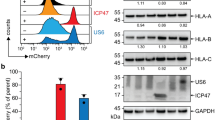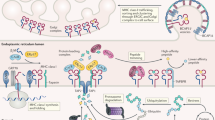Abstract
Fragments of foreign antigens associated with class I molecules of the major histocompatibility complex (MHC) are presented at the cell surface to elicit an immune response. This presentation requires the coordinated expression of several genes contained in the MHC1,2,3,4,5, including those encoding the MHC class I heavy chain, the proteins LMP-2 and LMP-7, which are involved in the proteasomal degradation of cytosolic antigens into peptide fragments that are destined for association with MHC class I molecules, and TAP-1 and TAP-2, which transport these fragments across the membrane of the endoplasmic reticulum at the start of their journey to the cell surface. In many virus-transformed cell lines6,7 and spontaneous tumours8,9,10, these genes are simultaneously repressed. However, the key factor(s) that are essential for their expression and repression have not been identified. Here we report that the proto-oncogene product PML induces expression of LMP-2, LMP-7, TAP-1 and TAP-2 in an MHC-class I-negative, recurrent tumour, leading to the re-expression of cell-surface MHC in tumours and to rejection of the tumours. PML also regulates MHC expression in untransformed fibroblasts. We conclude that malfunction of PML may enable a tumour to evade the immune defence of its host.
This is a preview of subscription content, access via your institution
Access options
Subscribe to this journal
Receive 51 print issues and online access
$199.00 per year
only $3.90 per issue
Buy this article
- Purchase on Springer Link
- Instant access to full article PDF
Prices may be subject to local taxes which are calculated during checkout




Similar content being viewed by others
References
White, L. C. et al. Regulation of LMP2 and TAP1 genes by IRF-1 explains the paucity of CD8 T cells in IRF-1(−/−) mice. Immunity 5, 365–376 (1996).
Matinez, C. K. & Monaco, J. J. Homology of proteasome subunits to a major histocompatibility complex-linked LMP gene. Nature 353, 554–667 (1991).
Trowsdale, J. et al. Sequences encoded in the class II region of the MHC related to the ‘ABC’ superfamily of transporters. Nature 348, 741–744 (1990).
Townsend, A. R. M. et al. The epitope of influenza nucleoprotein recognized by cytotoxic lymphocytes can be defined with short synthetic peptides. Cell 44, 959–968 (1986).
Spies, T. et al. Agene in the human major histocompatibiity complex class II region controlling the class I antigen-presentation pathway. Nature 348, 744–747 (1990).
Rotem-Yehudar, R., Winograd, S., Sela, S., Coligan, J. E. & Ehrlich, R. Downregulation of peptide transporter genes in cell lines transformed with highly oncogenic adenovirus 12. J. Exp. Med. 180, 477–488 (1994).
Rotem-Yehudar, R., Groettrup, M., Soza, A., Kloetzel, P. M. & Ehrlich, R. LMP-associated proteolytic activities and TAP-dependent peptide transport for class I MHC molecules are suppressed in cell lines transformed by the highly oncogenic adenovirus 12. J. Exp. Med. 183, 499–514 (1996).
Restifo, N. P. et al. Identification of human cancers deficient in antigen-processing. J. Exp. Med. 177, 265–272 (1993).
Korkolopoulou, P., Kaklamanis, L., Pezzella, F., Harris, A. L. & Gatter, K. C. Loss of antigen-presenting molecule (MHC class I and TAP-1) in lung cancer. Br. J. Cancer 73, 148–153 (1996).
Vegh, Z., Wang, P., Vanky, F. & Klein, E. Selective down-regulated expression of major histocompatibility complex class I alleles in human solid tumors. Can. Res. 53, 2416–2420 (1993).
Ramarathinam, L., Castle, M., Wu, Y. & Liu, Y. Tcell costimulation by B7/BB1 induces CD8 T cell-dependent tumor rejection: an important role of B7/BB1 in the induction, recruitment, and effector function of antitumor T cells. J. Exp. Med. 179, 1205–1214 (1994).
Ramarathinam, L. et al. Multiple lineages of tumors express a common tumor antigen, P1A, but they are not cross-protected. J. Immunol. 155, 5323–5329 (1995).
Steimle, V., Otten, L. A., Zufferey, M. & Mach, B. Complementation cloning of an MHC class II transactivator mutated in hereditary MHC class II deficiency (or bar lymphocyte syndrome). Cell 75, 135–146 (1993).
Goddard, A. D. et al. Cloning of the murine homolog of the leukemia-associated PML gene. Mamm. Gen. 7, 732–737 (1995).
Perez, A. et al. PML/RAR homodimers: distinct DNA binding properties and heterodimeric interaction with RXR. EMBO J. 12, 3171–3182 (1993).
Fagioli, M. et al. Alternative splicing of PML transcripts predicts coexpression of several carboxy-terminally different protein isoforms. Oncogene 7, 1083–1091 (1992).
de Thé, H. C. et al. The PML-RARα fusion mRNA generated by the t(15:17) translocation in acute promyelocytic leukemia encodes a functionally altered RAR. Cell 66, 675–684 (1991).
Goddard, A. D., Borrow, J., Freemont, P. S. & Solomon, E. Characterization of a zinc finger gene disrupted by the t(15;17) in acute promyelocytic leukemia. Science 254, 1371–1374 (1991).
Grignani, F. et al. The acute promyelocytic leukemia-specific PML–RARα fusion protein inhibits differentiation and promotes survival of myeloid precursor cells. Cell 74, 423–431 (1993).
Kakizuka, A. et al. Chromosomal translocation t(15;17) in human acute promyelocytic leukemia fuses RARα with a novel putative transcriptional factor, PML. Cell 66, 663–674 (1991).
Yoshida, H. et al. Accelerated degradation of PML-retinoic acid receptor alpha (PML-RARα) oncoprotein by all-trans-retinoic acid in acute promyelocytic leukemia: possible role of the proteasome pathway. Cancer Res. 56, 2945–2948 (1996).
Lavau, C. et al. The acute promyelocytic leukemia-associated PML gene is induced by interferon. Oncogene 11, 871–876 (1995).
Blanar, M. A., Baldwin, A. S. J, Flavell, R. A. & Sharp, P. A. Aγ-interferon-induced factor that binds the interferon response sequence of MHC class I gene, H–2Kb. EMBO J. 8, 1139–1144 (1989).
Gambacorta, M. et al. Heterogeneous nuclear expression of the promyelocytic leukemia (PML) protein in normal and neoplastic human tissue. Am. J. Pathol. 149, 2023–2035 (1996).
Koken, M. H. M. et al. The PML growth-suppressor has an altered expression in human oncogenesis. Oncogene 10, 1315–1324 (1995).
Carvalho, T. et al. Targeting of adenovirus E1A and E4-ORF3 proteins to nuclear matrix-associated PML bodies. J. Cell. Biol. 131, 45–56 (1995).
Durbin, J. E., Hackenmiller, R., Simon, M. C. & Levy, D. E. Targeted disruption of the mouse stat1 gene results in compromised innate immunity to viral disease. Cell 84, 443–450 (1996).
Lanotte, M. et al. NB4, a maturation-inducible cell line with t(15:17) marker isolated from a human promyelocytic leukemia (M3). Blood 77, 1080–1086 (1991).
Guo, Y., Wu, Y., Shinde, S. & Liu, Y. Identification of CD44H as a costimulatory molecule rapidly induced by CD40 ligand. J. Exp. Med. 184, 955–961 (1996).
Oi, V. T., Morrison, S. L., Herzenberg, L. A. & Berg, P. Immunoglobulin gene expression in lymphoid cells. Proc. Natl Acad. Sci. USA 80, 825–829 (1983).
Acknowledgements
We thank V. Nussenzweig, X.-H. Sun and X. D. Fu for discussions and for critically reading the manuscript; J. Hirst for flow cytometry; B. Mach for the EBO-Sfi vector; S. Vukmanovic for the Kd cDNA clone; M. Lanotte for NB4 cells; and F. Hitchcock for help with preparing the manuscript. This study was supported by grants from the NIH and by the Kaplan Comprehensive Center of NYU Medical Center and by Ohio State University Comprehensive Cancer Center.
Author information
Authors and Affiliations
Corresponding author
Rights and permissions
About this article
Cite this article
Zheng, P., Guo, Y., Niu, Q. et al. Proto-oncogene PML controls genes devoted to MHC class I antigen presentation. Nature 396, 373–376 (1998). https://doi.org/10.1038/24628
Received:
Accepted:
Issue Date:
DOI: https://doi.org/10.1038/24628
This article is cited by
-
Tumor-induced escape mechanisms and their association with resistance to checkpoint inhibitor therapy
Cancer Immunology, Immunotherapy (2019)
-
Bone marrow T-cell percentage: A novel prognostic indicator in acute myeloid leukemia
International Journal of Hematology (2017)
-
The function, regulation and therapeutic implications of the tumor suppressor protein, PML
Cell & Bioscience (2015)
-
Coordinated regulation of the immunoproteasome subunits by PML/RARα and PU.1 in acute promyelocytic leukemia
Oncogene (2014)
-
The genotype of the transporter associated with antigen processing gene affects susceptibility to colorectal cancer in Japanese
Environmental Health and Preventive Medicine (2014)
Comments
By submitting a comment you agree to abide by our Terms and Community Guidelines. If you find something abusive or that does not comply with our terms or guidelines please flag it as inappropriate.



